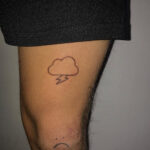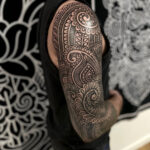Chinese Language Tattoos have surged in popularity in Western culture, adorning individuals from celebrities to everyday people. The allure of intricate characters and the perception of profound meaning have drawn many to ink Chinese symbols onto their skin. However, this trend is not without its complexities and potential pitfalls. Often, the path to meaningful body art is riddled with mistranslations and cultural misunderstandings, turning what was intended to be a powerful statement into something unintentionally humorous or even offensive.
One of the most cited examples of this is Britney Spears’ infamous tattoo, intended to mean “mysterious” but reportedly translating closer to “strange.” This anecdote is far from isolated. Many seeking tattoos representing concepts like “freedom” end up with characters signifying “free of charge” (mian fei), while aspirations of “power” can mistakenly become “electricity” (dian). These humorous missteps highlight a crucial point: navigating the nuances of Chinese language tattoos requires careful consideration and respect.
The Allure and the Misinterpretations
The appeal of Chinese character tattoos is multifaceted. For some, it’s the aesthetic beauty of the script itself – the elegant strokes and calligraphic style. For others, it’s the perceived depth and mystique associated with a language and culture vastly different from Western norms. The idea of imbuing oneself with ancient wisdom or powerful symbolism through these characters is undeniably attractive.
However, the very elements that make Chinese characters appealing also contribute to the potential for misinterpretation. The Chinese language is rich with homophones and characters that can have drastically different meanings depending on context. Direct, word-for-word translation tools often fail to capture these subtleties, leading to tattoos that are grammatically incorrect, semantically nonsensical, or simply not what the wearer intended.
Furthermore, the trend of Chinese language tattoos has, for some, become associated with cultural appropriation. For individuals of Asian descent, seeing these tattoos on those unfamiliar with the culture can evoke complex feelings. It can feel like a superficial adoption of symbols stripped of their deeper cultural significance, reducing a rich heritage to mere decoration.
Navigating Cultural Sensitivity
The question of cultural sensitivity is central to the discussion around Chinese language tattoos. While intent may be harmless, the impact can be more nuanced. For Asian Americans and others connected to Chinese culture, these tattoos can sometimes feel like a perpetuation of stereotypes or a trivialization of their heritage.
This sentiment is rooted in historical context. Western culture has a history of exoticizing and misrepresenting Asian cultures, often through caricature and stereotype. These misrepresentations, whether through film, media, or fashion trends, can be hurtful and alienating for those whose identities are being portrayed. Chinese character tattoos, in some contexts, can be perceived as falling into this pattern of cultural appropriation.
However, perspectives within the Asian American community are diverse. Some individuals find the trend problematic, while others may be more accepting, particularly if they perceive genuine interest and respect behind the choice. Ultimately, there’s no single, definitive answer to whether a Chinese language tattoo is inherently culturally insensitive. It depends heavily on individual perspectives, motivations, and the level of awareness and respect demonstrated by the person getting the tattoo.
Personal Meaning and Respectful Engagement
Despite the potential pitfalls, Chinese language tattoos can hold deep personal meaning when approached with respect and diligence. The key lies in moving beyond superficial trends and engaging with the language and culture in a meaningful way. This involves more than just finding a character online that seems aesthetically pleasing or conceptually resonant.
It requires thorough research to ensure accurate translation and understanding of the chosen characters. Consulting with native speakers or experts in Chinese language and culture is crucial. This proactive approach demonstrates a genuine interest in the language and a desire to avoid unintentional misrepresentations.
Moreover, considering the cultural context of the chosen characters is essential. Some characters or phrases may carry specific cultural or historical connotations that are important to be aware of. Understanding these nuances adds depth to the tattoo and showcases a level of cultural sensitivity.
For some, the personal connection to Chinese language tattoos may stem from their own heritage or a deep appreciation for Chinese culture. For others, it might be about finding a unique and visually striking way to express personal values or beliefs. Regardless of the motivation, approaching the process with respect and a commitment to accuracy is paramount.
Tips for Getting a Chinese Language Tattoo Right
If you’re considering a Chinese language tattoo, here are some essential tips to ensure you do it right:
- Prioritize Accurate Translation: Don’t rely solely on online translators. Consult with native Chinese speakers or professional translation services specializing in cultural nuances.
- Understand the Meaning Beyond the Word: Explore the cultural context and potential connotations of the characters you choose.
- Seek Out Knowledgeable Tattoo Artists: Find an artist experienced in Chinese calligraphy or who demonstrates a willingness to work with you to ensure accuracy and cultural sensitivity.
- Focus on Personal Significance: Choose characters or phrases that hold genuine meaning for you, rather than simply following trends.
- Be Open to Feedback: If you’re unsure about your choices, seek feedback from people knowledgeable about Chinese language and culture. Be open to constructive criticism and willing to adjust your design if necessary.
Conclusion: Ink with Intention
Chinese language tattoos can be a powerful form of self-expression, offering a unique blend of aesthetics and symbolism. However, the journey to meaningful ink requires navigating potential pitfalls of mistranslation and cultural insensitivity. By prioritizing accuracy, engaging with the culture respectfully, and focusing on personal significance, you can ensure your Chinese language tattoo is not only visually appealing but also a true reflection of your intended meaning. Ultimately, the most impactful tattoos are those that are created with intention, awareness, and respect.

